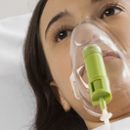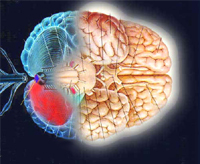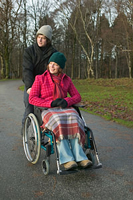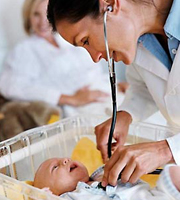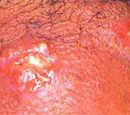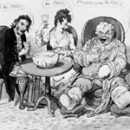Manifestations of chores are easy to confuse with grimacing. So if you noticed like your child «builds faces», Take this more closely: maybe the baby needs not in reprimand, but in medical examination. Incoming twitching in a child should be particularly alert if he recently suffered flu or angina.
Content
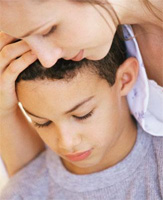 Many parents are surprised that by putting a diagnosis, the doctor often proposes to put a child in the rheumatological department of the hospital.
Many parents are surprised that by putting a diagnosis, the doctor often proposes to put a child in the rheumatological department of the hospital.
Often asked: what could be the connection between chorea and rheumatism?
With a concept «rheumatism» Usually bind diseases of the joints. This defeat is really the most obvious, but not the main thing. With rheumatism, the heart and vessels suffer mainly, the joints are involved in this process only briefly.
The nervous system suffers from all forms of rheumatism. But there is such a kind of variety, when it is on the nervous system that the main blow falls on the brain. This is chorea.
Translated from Greek «chorea» Means dance. «Dating Saint Vitta» called this disease in the Middle Ages. Indeed, the patient may sometimes seem like a person who performs some fancy dance: it twisters, makes sweeping movements, moves firmly by bouncing. Of course, these twitching (hypercines) and bouncing are performed involuntarily, the patient cannot stop them.
Sometimes the disease is called yet «Chorea Sidengama», named English doctor who first described it in 1686 and called «Small chorea». The last name has been fixed, and now most accepted.
Sick choral children predominantly school and preschool age. Up to three and after fifteen years she is extremely rare. It is observed that the girls are more inclined to this disease than boys.
Soray arises, like other forms of rheumatism, usually after angina, scarletin, influenza. Promotes its development also aggravating chronic foci of infection: chronic tonsillitis, sinusitis, sinusitis. There are cases of chore after severe mental injury. Sometimes it is not possible to find out the preceding causes.
Chorea develops gradually. The child becomes scattered, touchy, bewildered. Its movement loses clarity. Because of this, the handwriting is decessful, blots and blots appear in notebooks. He eats inaccurately, the items drops: something unusual appears in the Mimic - Grimasy, crushing. Than observing parents and teachers, the sooner they begin to understand that the child is not »Observed», And sick.
Unfortunately, for medical help usually do not immediately appeal, and such children fall into the hospital already when the disease is in full swing.
Even with the first inspection in the receiving department, the doctor notes the characteristic signs of Khore. Shiver and involuntary finger movements interfere with the child to independently. He cannot perform some simple movements: for example, with closed eyes first stretch your arms forward, and then touch the tip of the nose (finger-nasal sample). Even when he is asked to just feed his hand, he sometimes does it very embarrassing, somehow unnaturally turning his palm and producing many extra uncorrected movements.
Especially difficult to write a child. It is difficult to eat - a spoon puts somewhere towards the mouth; he can impass himself for a fork, knife.
The child is reluctant to speak, because during the conversation, pressing muscles of the face, involuntary movements.
Other characteristic signs of choreas - muscle weakness and reduction of muscle tone. Lying on the back, the child can, for example, to freely bring his knees to the chin; such a doctor's posture called the symptom «Peroral knife». If you try to raise it, keeping under the mouse, only shoulders rise, and the head goes deep between them (symptom «Drying shoulders»).
But with all this, no deviations in the state of the internal organs are not marked. Temperature remains normal or rises very slightly. Blood test also looks relatively safe.
Involuntary movements, muscle weakness not always pronounced. In recent years, the prevailing has become «erased» The form of chores, which is much more difficult to recognize, especially in the early stages.
Irritability, the instability of the mood, reduced performance at school - Here is its first signs. Following such mental disorders, motor concerns appear. It is also not so striking. There are no strong twitching, but parents must alarmed nonsense, instability gait, sludge in clothes.
Even less typical «paralytic» The shape of the chorea, when the phenomena of cutting muscle weakness protrude on the first plan in the picture.
Oddly enough at first glance, the sharp forms of Korea are often treatable faster (in 2-3 months) than the erased. With sluggish the flow, recovery occurs after 6-8 or even 12 months.
Sick child need to ensure peace and bed. The complex of therapeutic measures includes antimorphs, the arsenal of which is now large enough. These are antibiotics, and means lowering the excitability of the central nervous system, and hormones. Mandatory vitamins, especially B1, B2, B5, which are injected intramuscularly.
It has long been noticed that as it were, no hyperknesses, in a dream they are completely removed, and the child is completely calm. Already one thing that came up to the idea of the usefulness of a long sleep.
All measures are accepted in hospitals to sleep more. In the mode of the day of children of all ages, it is necessarily a day dream. Guys fit into special «Sleepy chambers». The role of sleeping equipment here successfully perform loud ticking hours, monotonous buzz of a buzzer or a knock of the metronome. Windows, as a rule, remain unmapped: After all, the child, as everything is growing, is necessary.
Physiotherapy, physiotherapy, physiotherapy are widely used. Recovery children are engaged in manual labor. Modeling, cutting, embroidery, knitting not only entertain them, but also serve as a good workout and muscle strengthening.
Khorora, as well as all forms of rheumatism, is peculiar to the wave-like flow. Signs of illness with at times strengthens, sometimes subsided. Fully disappeared, they can after a long break, even in a few years, again.
Disease «Returns» Under the action of any reasons weakening the body. This may be the result of not only an infectious process, overwork, but also strong excitement. Often, relapse is preceded by a quarrel between parents. It never seems to us that the child does not delve into the affairs of adults, but in reality he perceives everything, is deeply worried and ultimately becomes the most affected party.
However, no matter how heavy, long and waving the course of the ferret, still comes full recovery. Only some muscle weakness, a decrease in muscle tone and motor anxiety with excitement. But over time and it passes.
Chorery who have suffered, in the future develop normally and successfully cope with the school burden.
Unfortunately, there are not only «Clean» Forms of the Korea. With repeated attacks, it is often combined with other manifestations of rheumatism, more often - with the defeat of the heart. There is inflammation of the inner shell of the heart - endocarditis, the muscular shell - myocarditis, inflammation may appear and in the outer shell - pericardia.
Child worry pain in the heart, shortness of breath, heartbeat; The doctor discovers and objective signs of violation of cardiovascular activities. All this significantly lengthens the duration of the disease, worsens the prospects for complete recovery. The main danger is that the inflammatory process usually ends with the formation of heart defect.
It is necessary to try to prevent this disease in every way, and if it originated, as soon as possible to start treatment.
Attacks of rheumatism usually occur after angina, scarletin, influenza; Therefore, to prevent rheumatism, any form - nervous, cardiac or articular - it is necessary to timely and full-fledged treatment of these diseases.
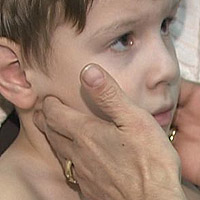 Carefully watch the condition of the child not only is it so sick, but then when the sharp period passed. For the tenth - fourteenth day after the start of an angina or influenza, the first signs of rheumatism may appear!
Carefully watch the condition of the child not only is it so sick, but then when the sharp period passed. For the tenth - fourteenth day after the start of an angina or influenza, the first signs of rheumatism may appear!
Khorora often arises in children suffering from chronic tonsillitis. They sometimes flow easily, without increasing the temperature and manifest only a small pain when swallowing and reddening. Parents often in these cases do not even appeal to the doctor, and the child is treated - in most cases incorrectly.
In children, patients with chronic tonsillitis, the almonds are constantly microbes that produce poisonous substances - toxins. These poisons are systematically entered into blood, spread through the body, poisoning it, deficify protective forces and, of course, harmful reflected on the nervous and cardiovascular systems. That is why it is necessary to persist with chronic tonsillitis, to be treated until complete recovery. It is also important to treat sick teeth to the child, chronic diseases of the nasal cavities, chronic purulent inflammation of the ear - otitis.
Child, after the hospital, preferably placed in a rheumatological sanatorium. If he stays at home, then two or three weeks it is not recommended to attend school. In class, he should turn on gradually. Agree with a school doctor and a class teacher that for the first two months after recovery, it was given an additional day off.
It is very advisable to save daylight (after lunch). The child must walk at least 2 every day - 3 hours. Feed it according to age, if possible, varied and fully, with such a calculation so that it receives more proteins (meat, fish, cottage cheese) and vitamins.
Rheumatism - the disease, mainly inherent in children, does not accidentally call it «enemy of youth». 60-70 percent of all cases of rheumatism falls at the children's age, and rheumatism, first identified after 40 years, is also most often turning out to be only a continuation of the process started in childhood.
Modern medicine has means capable of neutralize «enemy of youth», interrupt its destructive work. It is necessary to take advantage of these opportunities and means, fulfill all the advice of the doctor, to achieve complete recovery of the child.
So, remember:
- Khorora often develops after angina, scarletin, influenza;
- Carefully watch the child who suffered these diseases;
- If you have noticed irritability, focus, fuzziness movements, muscle twitching, consult a doctor immediately;
- Strictly follow the prescribed mode.


